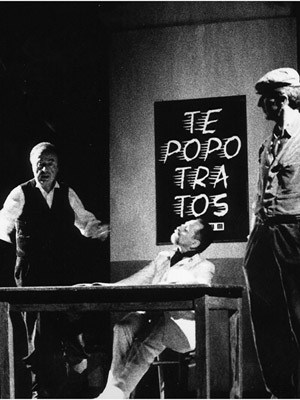The small village of Monticchiello in the heart of the Val d’Orcia in Tuscany is renowned for its local theater group the Teatro Povero di Monticchiello, the Poor Theater of Monticchiello. This company started in 1967 but the experience of theater in Monticchiello goes further back in time. The first productions were purely entertaining moments during the folk festivals that are part of village life. After the agricultural crisis, this “ritual” then became a way of overcoming the risk of isolation and disintegration of the fabric of society of the town. After the production of “The Heroine of Monticchiello” in 1967, the community and its critical situation started gaining attention.

“Autodramma”
In 1969 was the anniversary of an incident during the Resistance Movement: the victory “on the field” by the partisans and a thwarted slaughter by the Nazis in Monticchiello. The townsfolk, wanting to remember this event with a play, put on “That 6th of April of ‘44” written by Mario Guidotti, giving rise to the concept of “autodramma” or “acting as oneself” and the Teatro Povero di Monticchiello.
Following this production, theater in Monticchiello took on even more of a social function of provoking a continual examination of conscience in the greater community and of strengthening their roots by maintaining contact with real life.
The cooperative
In 1980 the theater group became a cooperative with the idea of contributing to informing and diffusing the culture, enhancing the historical-environmental resources of the territory and accessing state funding. The shows became more and more sophisticated. The cooperative, which was founded for bureaucratic and fiscal reasons, eventually took on an ideological role. The dramaturgical activity became more of a collective effort and the stage became a unified voice for all.

The main square, which has always been the main stage for daily life, for confessions, for decisions, transforms into a theatrical main stage for the “autodramma” productions every year. The 1981 production was in homage to the main square with the aim of showing what it represented in the past and what it might represent in the future. The square is the history of theater in Monticchiello and the analysis of the condition of the saturation of farming family themes which no longer exist: the new Poor Theater raises its curtain.
In 1982, the group decided to do without authors and directors. “Sorella acqua?” is written by a group of four people who, after following the same procedure in analyzing ideas, concepts and problems of the assembly, make them partake in a discussion and approve the script.
Today the Poor Theater of Monticchiello stages productions each year the last week in July, the first two weeks in August and during the Christmas season. Both periods are not so crowded in Tuscany and if you love theater can be a win-win choice planning a trip to the area and attending one of the plays.

Museum of the Popular Traditional Tuscan Theater
The TePoTraTos, Scenes from Popular Traditional Tuscan Theater, originates from the experience of the Poor Theater, which has made the farm life experience the core of its drama productions. The object on display was not an object, but rather a collection of the productions of the popular traditional theater, that theater which was produced by the farmers in all seasons of the year and which has been handed down from generation to generation.
One must go beyond the museum staging and onto a new road that allows the visitor-spectator to perceive emotions immersed in a communicative universe made up of sounds, voices, pieces of dialogue, objects, images that recall the farm life. The museum is in the “Granaio del Popolo”, the “Granary of the People”, a building from 1700 bought by the theater cooperative signifying a sort of historical redemption: a place that for centuries stored fruits of exhaustive labor of the sharecroppers was given back to the people.




